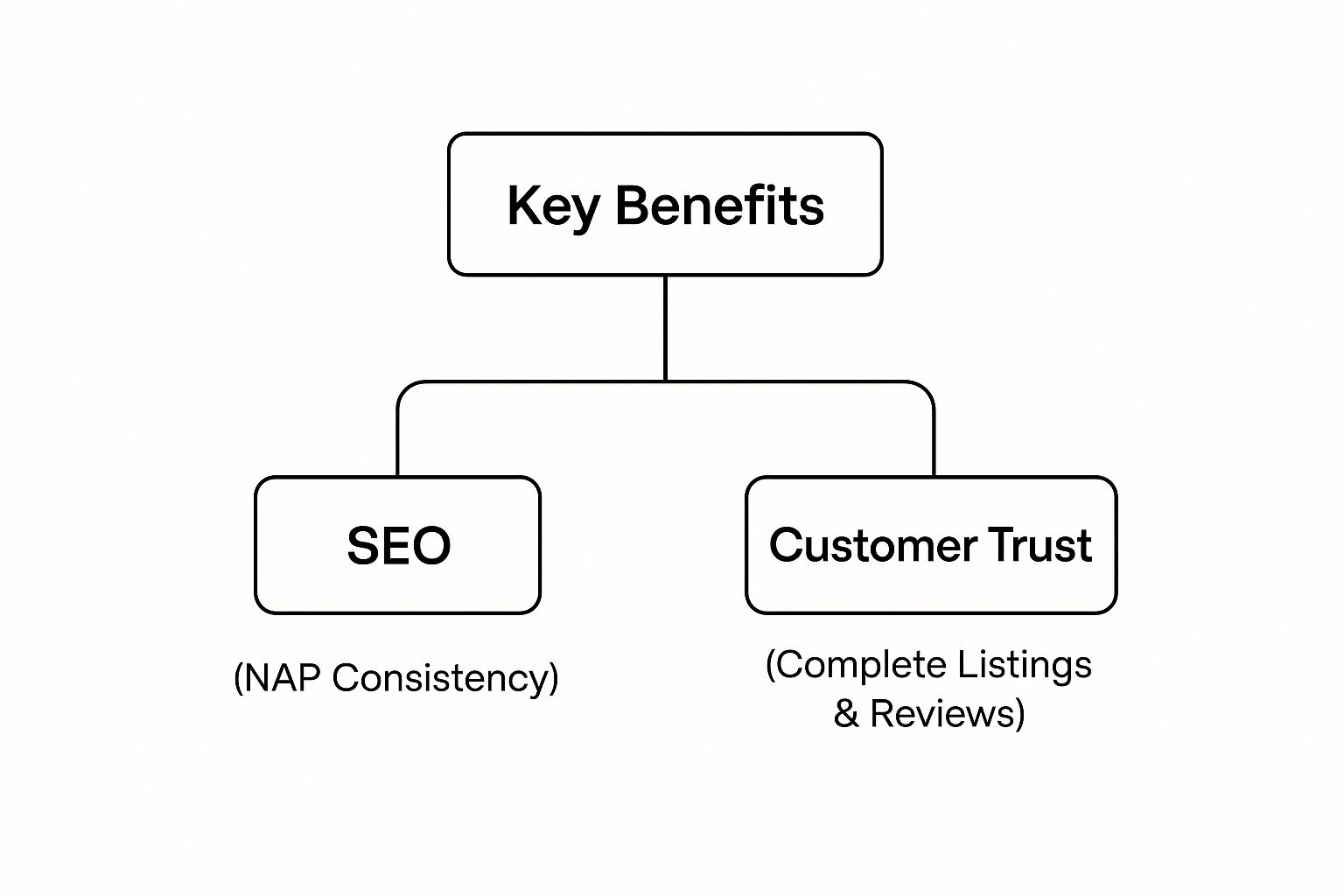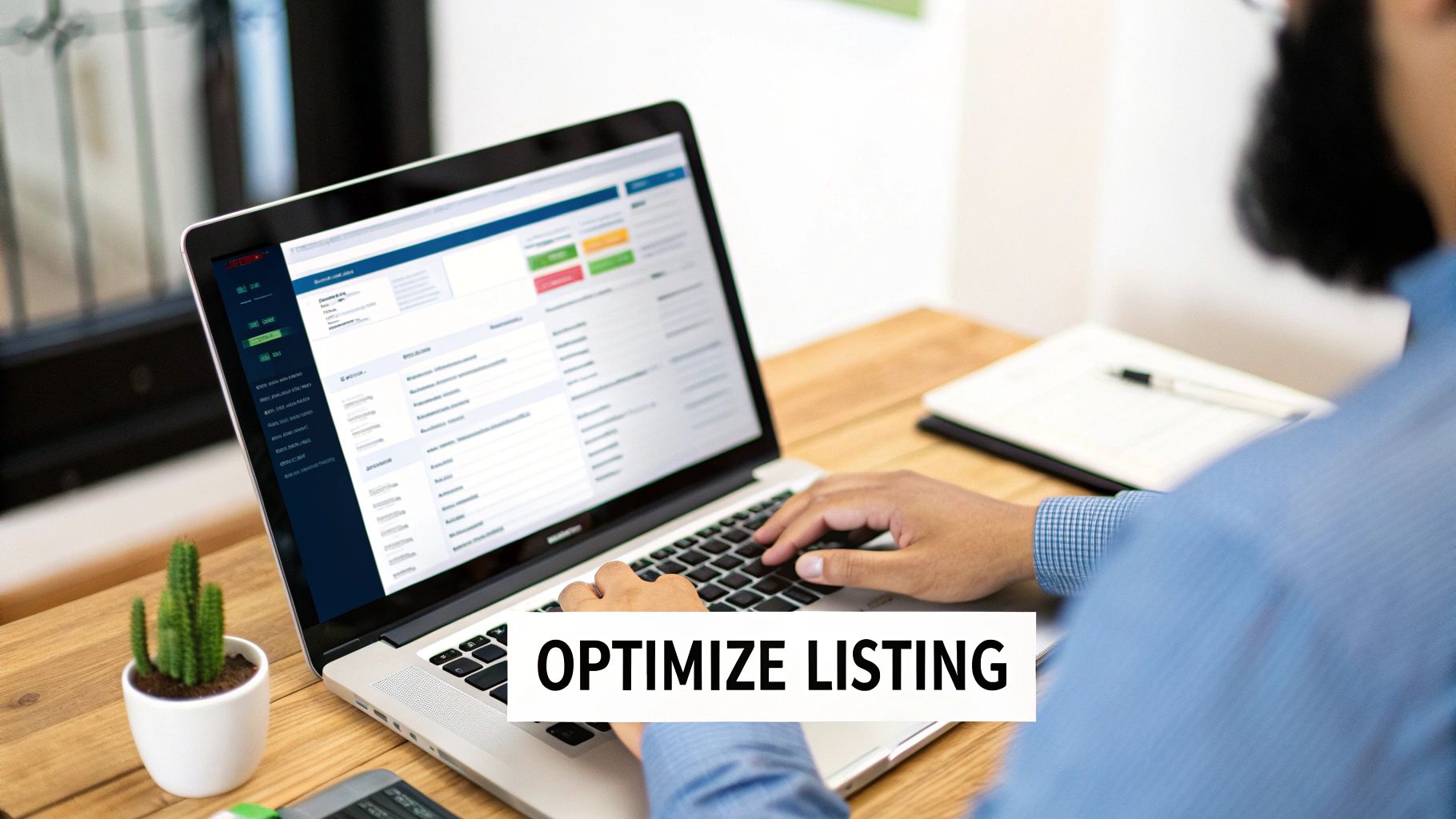Think of a local directory listing as your business’s profile on sites like Google, Yelp, or Bing. It’s a digital business card that holds your essential details—name, address, and phone number—so both customers and search engines can easily find you and confirm you’re a real, operating business.
What Is a Local Directory Listing Anyway?

Let’s use an analogy. Imagine your business has a digital passport. A local directory listing is the official stamp in that passport for every online platform it “visits,” from giants like Google Business Profile to niche, industry-specific directories. This isn’t just an entry in some online phonebook; it’s a cornerstone of your digital identity that proves you’re legit.
When someone nearby pulls out their phone and searches for “plumbers near me,” Google springs into action like a detective. It scours the web for clues to recommend the most relevant and trustworthy businesses. Every consistent directory listing it finds is another piece of evidence confirming your business is real, located where you claim, and ready to help.
The Building Blocks of Your Digital Identity
This “digital passport” is built on a few core pieces of information, often called your NAP data. Consistency across all your listings is absolutely critical. Even a tiny difference, like using “St.” on one site and “Street” on another, can confuse search engines and turn away potential customers.
The main components are simple:
- Business Name: Your official, registered business name.
- Address: The physical storefront or office where customers can find you.
- Phone Number: Your primary contact number.
These listings go hand-in-hand with another key concept in local SEO. To really connect the dots, it helps to understand what a local citation is and see how it builds on this foundation.
Simply put, a local directory listing is a public-facing profile that contains your business’s essential information. It’s the reference point that search engines and consumers use to verify who you are, what you do, and where you’re located.
Without these verified “stamps” in your digital passport, your business is practically invisible in local search results. Building an accurate and widespread presence across many directories is the first step for any business hoping to attract nearby customers, establish credibility, and grow.
Why Your Business Can’t Afford to Ignore Local Listings
Picture this: you’ve just opened a brand-new shop, poured your heart into it, but forgotten one crucial thing—the sign out front. People walk right by, completely oblivious to your existence. A local directory listing is that sign for the digital world, and without it, you’re essentially doing business in the dark. It’s the most fundamental way to tell both search engines and potential customers, “Hey, I’m here, and I’m open for business!”
These listings pull double duty, and both functions directly impact your revenue. First, they are a massive driver for search engine optimization (SEO), putting you on the map for people actively looking for what you offer. Second, they build the kind of trust that converts a casual browser into a loyal customer.
The infographic below neatly illustrates how these two pillars—SEO and customer trust—are built on the foundation of well-managed local listings.

As you can see, consistent business information (your NAP) is the bedrock of local SEO. At the same time, complete profiles packed with great reviews are what truly earn a customer’s confidence.
Boosting Your SEO with NAP Consistency
When someone types “coffee shop near me” into Google, the search algorithm springs into action. Think of it like a detective scouring the internet for clues to determine the most accurate and trustworthy results. The single most important clue it looks for is consistent NAP data: your business Name, Address, and Phone number.
When your NAP is perfectly identical across your Google Business Profile, Yelp, Bing Places, and other key directories, it sends a powerful signal to search engines. They see this consistency as a mark of legitimacy, which makes them far more likely to rank you in the highly-visible local map pack. This isn’t just about looking good; it’s a direct pipeline to new customers.
Every consistent local directory listing acts as a trusted citation, reinforcing your business’s credibility in the eyes of search engines. The more consistent citations you have, the higher your chances of ranking for valuable “near me” searches.
The impact isn’t small, either. It compounds over time. Research has shown that businesses that get their listings on 10 or more directories see a staggering 91% increase in local search visibility. On top of that, complete profiles were found to boost website clicks by 69%. This proves that putting in the effort to be detailed and accurate drives real-world results. You can explore more on this in various studies on local listing management statistics.
Building Customer Trust and Credibility
Beyond the technical side of SEO, a polished local directory listing is your digital storefront. An incomplete or inaccurate profile is like a shop with dusty windows and a flickering sign—it just doesn’t inspire confidence. It creates friction and doubt, sending potential customers straight to your competitors.
Imagine a customer finds your restaurant on Yelp, but the phone number is wrong. They try to call to make a reservation, get a disconnected tone, and immediately give up and find another place to eat. You just lost a customer over a simple, fixable error.
A professional listing, on the other hand, builds instant credibility. It includes key elements that make a customer feel secure in their choice:
- High-Quality Photos: Show off your products, your team, and your welcoming space.
- Accurate Hours: Save customers the frustration of showing up to a closed business.
- Positive Reviews: Let happy customers do the selling for you with powerful social proof.
These details transform a basic name and address into a compelling reason to choose you. They tell a story of a legitimate, professional, and trustworthy business, making it that much easier for a searcher to decide to visit your store, give you a call, or click through to your website.
Choosing the Right Directories for Your Business
Trying to get your business listed on every single directory out there is like trying to put a flyer under every windshield in the country. It’s a ton of work for very little return. A much better approach is to be strategic and focus your energy where it actually counts.
Not all directories are created equal. The goal isn’t to be everywhere; it’s to be everywhere that matters to your customers. Think of it as building a strong, relevant portfolio of listings that connects you with the right people.
The Three Tiers of Local Directories
The best way to get a handle on the world of local directories is to break it down into a simple hierarchy. Once you understand these different levels, you can prioritize your efforts and get the biggest bang for your buck.
Here’s how they stack up:
- Major Data Aggregators: These are the big data wholesalers. Think of platforms like Foursquare, which feed your business information to hundreds of other smaller apps, websites, and directories. Getting your info right at this source is fundamental; it’s the foundation that prevents bad data from creeping into listings all over the web.
- Popular Consumer Platforms: This tier is made up of the household names that your customers use every single day to find and vet businesses. We’re talking about the titans: Google Business Profile, Yelp, and Bing Places. For almost any local business, having a top-notch, fully optimized presence here isn’t just a good idea—it’s essential.
- Niche and Industry-Specific Directories: These are the specialty directories built for a specific field. If you’re a lawyer, that might be a site like Avvo. For a home remodeler, it could be Houzz. These platforms are powerful because they attract a pre-qualified audience actively looking for the exact services you provide.
A classic rookie mistake is chasing a long list of listings instead of a strong one. A single listing on a high-authority niche directory that your ideal customers trust is worth more than ten listings on generic sites nobody’s ever heard of.
To give you a clearer picture, I’ve put together a table comparing some of the top platforms across these categories.
Top Local Directory Platforms Compared
This table breaks down some of the most impactful directories, both general and niche-specific, to help you see where your business fits in.
| Directory Platform | Primary Audience | Key Feature / Best For |
|---|---|---|
| Google Business Profile | Virtually all local searchers | Dominating local search results and maps; essential for everyone. |
| Yelp | Consumers seeking reviews & recommendations | Building social proof and engaging with a review-savvy audience. |
| Bing Places | Users of the Bing search engine | Capturing a smaller but still significant segment of the search market. |
| Foursquare | Data syndication networks & app developers | Ensuring foundational data consistency across hundreds of other platforms. |
| Tripadvisor | Travelers and tourists | Restaurants, hotels, and attractions looking to attract visitors. |
| Houzz | Homeowners seeking renovation/design pros | Contractors, interior designers, and architects showcasing their work. |
| Avvo | Individuals seeking legal representation | Lawyers and law firms building credibility and attracting clients. |
| Healthgrades | Patients looking for doctors and dentists | Healthcare providers managing their online reputation and patient reviews. |
Choosing the right mix from this list—and others like it—is what separates a scattershot approach from a targeted, effective strategy.
Building Your Priority List
So, where do you actually start? Simple. Begin with the platforms that give you the biggest and most immediate impact, then work your way down the list.
First, lock down and perfect your profiles on the major consumer-facing players like Google and Yelp. These are today’s Yellow Pages, and they are absolutely critical for your general visibility.
Next, do a little digging to find the top two or three niche directories in your field. A quick Google search for “[your industry] + directory” is often all it takes to find the heavy hitters. These sites cement your status as an expert and put you in front of a highly motivated audience. If you need some ideas, you can explore a comprehensive local directory list to see what platforms are a good fit.
Finally, circle back to the major data aggregators to make sure your core information is accurate. This is your safety net, ensuring your foundational NAP (Name, Address, Phone) data is consistent everywhere it shows up online. This step-by-step process turns an overwhelming task into a manageable and powerful strategy that drives real-world results.
How to Create and Optimize Your Listings

Think of creating a local directory listing as putting up a digital sign for your business. It tells people you exist. But optimizing that listing? That’s what turns your simple sign into a powerful magnet that actively pulls in new customers. This is the difference between just being online and actually winning local searches.
The whole process hinges on one core principle: 100% completeness and accuracy. Every single field in your profile—from your business name to your hours—is a piece of a puzzle. If one piece is missing or wrong, it creates a confusing picture for both potential customers and the search engines trying to recommend you.
Nailing the Non-Negotiable Basics
Before you dive into the fancy stuff, you have to get the fundamentals absolutely right. This is the bedrock of any successful local listing, and the main goal is iron-clad consistency across every platform where your business appears.
Start with your NAP data:
- Name: Use your official business name. Exactly as it appears on your legal documents. No keywords, no fluff.
- Address: This needs to be identical everywhere, right down to the punctuation. If you use “St.” on one profile, you better not use “Street” on another.
- Phone Number: List your main, local business number. And stick with it.
Beyond the NAP, a few other details need the same level of attention:
- Website URL: Always link to the same page, whether it’s your homepage or a specific location page.
- Business Hours: Keep them updated religiously, especially for holidays or special events.
- Primary Category: Pick the one category that best describes what you do.
This consistency is a massive trust signal for search engines. It tells them they can rely on your information, making them more likely to show your business. In fact, companies with consistent and optimized profiles are 32% more likely to show up in the coveted Google local pack.
Beyond the Basics: Advanced Optimization
Once your foundation is rock-solid, it’s time to add the details that make your listing shine. A bare-bones profile is functional, but a fully fleshed-out one is what convinces a searcher to click, call, or visit you instead of the competition.
A complete listing gets you found. A rich, optimized listing gets you chosen. It’s the difference between being on the map and being the destination.
Put your energy into these high-impact areas:
- Upload High-Quality Media: Don’t stop at one or two photos. Add at least 10 crisp, high-resolution images of your storefront, products, team, and happy customers. Videos are even better for grabbing attention.
- Write a Compelling Description: Go beyond a sterile list of services. Tell a story. Naturally include local keywords (like “the best pizza in downtown Austin”) to signal to Google who you serve.
- Encourage and Respond to Reviews: Actively ask your satisfied customers to leave a review. Just as important, make sure you respond to all of them—the good and the bad. It shows you’re engaged and you care.
- Utilize Platform-Specific Features: Many directories offer extra tools like Google Posts, Q&A sections, or product catalogs. Use them! They provide fresh content for search engines and give customers more reasons to engage.
To really get the most out of your listings, they shouldn’t exist in a vacuum. They become exponentially more powerful when they’re part of a cohesive strategy, often guided by professional Search Engine Optimization (SEO) services. For a deeper dive into these techniques, check out our guide on local business listing optimization.
Managing Your Listings and Reputation at Scale
Getting your first wave of local directory listings live is a fantastic first step, but the job isn’t done. Think of your listings less like a “set it and forget it” task and more like a garden. They need consistent attention to thrive.
Over time, small inaccuracies will inevitably pop up, and they can undo all the hard work you put into establishing consistency. This is where managing your listings at scale gets tricky.
Little errors, like an outdated address or a simple typo in your business name, get picked up and spread across the web by data aggregators. This is a phenomenon we call data drift, and it creates confusion for both search engines and potential customers. Bit by bit, it chips away at your local SEO authority and your credibility.
You also have to watch out for duplicate listings that get created by accident or even unauthorized edits made by random users. Both of these can make your online presence look messy and unprofessional.
Manual Management vs. Automated Software
When it comes to keeping your listings in order, you’ve got two main choices: do it all yourself by hand, or let specialized software handle the heavy lifting. Each path has its own pros and cons.
Manual management is exactly what it sounds like. You log in to every single directory, one by one, to make any changes. While it doesn’t cost any money, it becomes a massive time sink and a recipe for mistakes once you’re on more than a handful of sites. Just imagine trying to update your holiday hours across 30 different platforms.
Automated listing management software, on the other hand, gives you a central command center. You update your information once in the dashboard, and the software syncs that change across dozens or even hundreds of directories for you. It saves a staggering amount of time, guarantees consistency, and even helps find and fix duplicate listings. Yes, it’s a paid service, but for a growing business, the accuracy and efficiency gains are almost always worth it.
The right approach really comes down to your resources. If you’re a new business with just five listings, you can probably get by manually. But once you hit 20+ listings, an automated tool will save you from major headaches and costly errors.
Integrating Reputation Management
A huge piece of the management puzzle is your reputation. Reviews are front and center on nearly every directory, and a whopping 88% of consumers say they trust online reviews as much as a recommendation from a friend. You simply can’t afford to ignore them.
Keeping an eye on reviews and responding to them across all your different profiles is a critical, ongoing job. It means you need to be:
- Responding quickly to both happy and unhappy customers.
- Thanking people who leave positive feedback.
- Addressing complaints professionally and trying to make things right.
This kind of consistent engagement sends a powerful signal to potential customers that you’re an owner who truly cares about their experience. To make this process easier and ensure you’re protecting your brand’s image everywhere, you might want to look into the best online reputation management tools. They pull all your reviews into one place, making it much simpler to maintain a five-star reputation as you grow.
Common Local Directory Listing Mistakes to Avoid

Getting your business listed on local directories is a huge first step. But the hard truth is, even tiny, seemingly harmless mistakes can quietly sabotage all your hard work. Steering clear of these common slip-ups is just as vital as getting the basics right in the first place.
The absolute worst offender? Inconsistent NAP information. That’s your business Name, Address, and Phone number. It’s when you use “St.” on one site but “Street” on another, or have an old phone number floating around. These small differences seem trivial, but to a search engine, they create a real identity crisis.
This confusion torpedoes your visibility. Research shows that businesses with perfectly consistent NAP data across the most important citation sites can see their local search visibility jump by as much as 25%. You can dig deeper into how citation accuracy impacts rankings.
Overlooking Key Optimization Details
Beyond getting your core info straight, plenty of other errors can weaken your listing’s pull and even push customers away. You have to treat your listing like a digital storefront, not just a box to check.
A local directory listing isn’t just a record in a database; it’s your business’s first impression. An incomplete or neglected profile tells customers you don’t pay attention to the details.
Make sure you’re not guilty of these frequent missteps:
- Choosing the Wrong Business Category: This is a classic. If you pick a category that’s too broad or just plain wrong, you’re invisible to people searching for exactly what you offer. Always get as specific as you can.
- Neglecting Visuals: A listing with no photos is a red flag. It feels empty and a little sketchy. High-quality images of your location, your products, and your team build trust and draw people in instantly.
- Ignoring Customer Reviews: Nothing says “we don’t care” louder than ignoring reviews—especially the bad ones. Actively engaging with feedback, good and bad, shows everyone you stand behind your business.
By sidestepping these common blunders, you’ll create a powerful local listing that doesn’t just exist—it actively works to bring in new customers and climb the search rankings.
Common Questions About Local Listings
Getting started with local directory listings usually brings up a few key questions. Let’s walk through some of the most common ones business owners ask as they start putting these ideas into practice.
How Long Until I Actually See SEO Results?
It’s the million-dollar question, isn’t it? While a simple update like a new phone number might show up in a few days, the real SEO impact takes a bit longer to kick in. You should start seeing a noticeable shift in your local search rankings within 2 to 6 months.
Why the wait? Think of it like building trust with a new acquaintance. Search engines need time to crawl all these different sites, see your consistent information, and verify that your business is legitimate and reliable. It’s that consistent, long-term presence that earns you their trust and, eventually, higher rankings.
Patience really is a virtue with local SEO. Every correct listing you create is another brick in your foundation. A solid foundation lets you build your rankings much higher over time.
What Do I Do If My Business Info Is Wrong Somewhere?
Finding incorrect information about your business online is definitely frustrating, but the good news is, it’s almost always fixable. Your first move should be to claim the listing on that specific directory. Most platforms have a straightforward verification process that lets you take ownership of the profile.
Once you’re in, you can edit the incorrect details yourself. If for some reason you can’t claim it, look for a “suggest an edit” or “report a problem” link. And if all else fails, reaching out to the directory’s support team directly is your final step. Tackling these errors is crucial—they don’t just hurt your SEO, they can send potential customers to the wrong place.
Should I Pay for a Listing or Stick with the Free Ones?
For most businesses, the best strategy is to focus on perfecting your free listings first. Start with the heavy hitters—Google Business Profile, Bing Places, and Yelp—and make them absolutely flawless. The value you get from these foundational profiles is massive.
Paid listings can sometimes give you a boost, like priority placement or removing competitor ads from your page. But you should only consider paying for a spot after your free profiles are 100% complete, you have the budget for it, and the directory is a super-relevant niche site where you know your ideal customers hang out.
Ready to take control of your online presence and turn customer feedback into your most powerful marketing tool? Reviews To The Top simplifies the entire process, from managing your listings to generating five-star reviews that attract new customers. Learn more about how Reviews To The Top can help your business grow.
